By Stephen Chun
Muni buses and private vehicles with two or more occupants will soon see an innovative solution for San Francisco: High Occupancy Vehicle lanes (HOV) on city streets, approved by a 5-1 vote on April 20 by the SFMTA Board of Directors. The historic pilot program, in partnership with Caltrans, aims to increase person-carrying capacity and improve transit reliability on several major corridors through Golden Gate Park, the Marina District and Cow Hollow.

This HOV pilot will help customers who ride the 28 19th Avenue Muni line
The HOV lanes will be in effect weekdays from 5 a.m. to 8 p.m. in the far-right lanes on State Route 1’s Crossover Drive (southbound only), Park Presidio Bypass and Park Presidio Boulevard between Lincoln Way and just north of Lake Street, and on U.S. 101’s Lombard Street and Richardson Avenue between Francisco and Lyon streets and Franklin and Gough streets.
Caltrans is currently in the final stages of roadwork on Lombard Street. Once that work is complete and Caltrans grants final approvals of the changes, the new HOV lanes will be striped. Park Presidio Boulevard should be restriped shortly thereafter.
With these changes in place, the far-right lane can continue to be used by motorists for right turns, driveway access and access to curbside loading and parking spaces. No parking and loading spaces will be removed as part of the project.
The pilot will end within 120 days after the city’s COVID-19 state of emergency order is lifted. The project could not be made permanent without an extensive public process and a second round of approvals by the SFMTA Board. A few weeks after implementation, the Agency will begin evaluating the project and gathering community input to determine if the pilot should be made permanent.
Project Benefits
In alignment with the Agency’s mission, the aim of these HOV lanes is to assist in moving more people as quickly and efficiently as possible. Efficient transit brings shorter and more reliable travel times for those who rely on public transit the most. These continued efforts to provide quicker travel times also improve the sustainability of our recovering economy.
Studies conducted late last year show that one-third of vehicles on these routes already carry two or more occupants. As each of the project’s roadways is three lanes, there should only be minimal impact to traffic initially. Over time, if the share of single-occupant vehicles increases, transit and high occupancy vehicles would be protected from increasing traffic congestion. The lanes could be converted from HOV-2 to HOV-3 later, increasing the required occupants per vehicle to three or more people if both the SFMTA and Caltrans agreed that doing so would further increase the total capacity of the roadway.
Published May 11, 2021 at 04:15AM
https://ift.tt/3bfc2ku
Comments